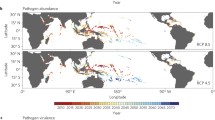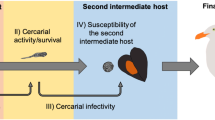Abstract
Since 1997, an emergent fungal disease named lethargic crab disease (LCD) has decimated stocks of the edible mangrove land crab Ucides cordatus (Linnaeus, 1763) (Brachyura: Ocypodidae) along the Brazilian coast, threatening the mangrove ecosystem and causing socioeconomic impacts. Evidence from a variety of sources suggests that the black yeast Exophiala cancerae (Herpotrichiellaceae, Chaetothyriales) has been responsible for such epizootic events. Based on the spatiotemporal patterns of the LCD outbreaks, the well-established surface ocean currents, and the range of ecological traits of Exophiala spp., a marine dispersal hypothesis may be proposed. Using in vitro experiments, we tested the survival and growth of E. cancerae CBS 120420 in a broad combination of salinities, temperatures, and exposure times. While variation in salinity did not significantly affect the growth of colony-forming units (CFUs) (P > 0.05), long exposure times visibly influenced an increase in CFUs growth (P < 0.05). However, higher temperature (30 °C) caused a reduction of about 1.2-fold in CFUs growth (P < 0.05). This result suggests that sea surface temperatures either above or below the optimum growth range of E. cancerae could play a key role in the apparent north–south limits in the geographical distribution of LCD outbreaks. In light of our results, we conclude that a fundamental step toward the understanding of LCD epidemiological dynamics should comprise a systematic screening of E. cancerae in estuarine and coastal waters.





Similar content being viewed by others
References
Boeger WA, Pie MR, Ostrensky A, Patella L. Lethargic crab disease: multidisciplinary evidence supports a mycotic etiology. Mem Inst Oswaldo Cruz. 2005;100:161–7.
Nóbrega RR, Nishida AK. Aspectos socioeconômicos e percepção ambiental dos catadores de caranguejo-uçá, Ucides cordatus (L. 1763) (Decapoda, Brachyura) do estuário do rio Mamanguape, Nordeste do Brasil (in Portuguese). Interciencia. 2003;28:36–43.
Alves RR, Nishida AK, Hernández MI. Environmental perception of gatherers of the crab “caranguejo-uçá” (Ucides cordatus, Decapoda, Brachyura) affecting their collection attitudes. J Ethnobiol Ethnomed. 2005;. doi:10.1186/1746-4269-1-10.
Boeger WA, Pie MR, Vicente VA, Ostrensky A, Hungria D, Castilho GG. Histopathology of the mangrove land crab Ucides cordatus (Ocypodidae) affected by lethargic crab disease. Dis Aquat Organ. 2007;78:73–81.
Ferreira CP, Pie MR, Esteva L, Mancera PFA, Boeger WA, Ostrensky A. Modelling the lethargic crab disease. J Biol Dyn. 2009;3(6):620–34.
De Hoog GS, Vicente VA, Najafzadeh MJ, Harrak MJ, Badali H, Seyedmousavi S. Waterborne Exophiala species causing disease in cold-blooded animals. Persoonia. 2011;. doi:10.3767/003158511X614258.
Orélis-Ribeiro R, Boeger WA, Vicente VA, Chammas M, Ostrensky A. Fulfilling Koch’s postulates confirms the mycotic origin of lethargic crab disease. Antonie Van Leeuwenhoek. 2011;99:601–8.
Pie MR, Boeger WA, Patella L, Vicente VA, Orélis-Ribeiro R, Ostrensky A. Specific primers for the detection of the black-yeast fungus associated with the lethargic crab disease. Dis Aquat Organ. 2011;94:73–5.
Vicente VA, Orélis-Ribeiro R, Najafzadeh MJ, Sun J, Guerra RS, Miesch S, Ostrensky A, Meis JF, Klaassen CH, de Hoog GS, Boeger WA. Black yeast-like fungi associated with lethargic crab disease (LCD) in the mangrove-land crab, Ucides cordatus (Ocypodidae). Vet Microbiol. 2012;158:109–22.
Avila RP, Mancera PFA, Esteva L, Pie MR, Ferreira CP. Traveling waves in the lethargic crab disease. Appl Math Comput. 2012;218(19):9898–910.
Guerra RS, do Nascimento MMF, Miesch S, Najafzadeh MJ, Orélis-Ribeiro R, Ostrensky A, de Hoog GS, Vicente VA, Boeger WA. Black yeast biota in the mangrove, in search of the origin of the lethargic crab disease (LCD. Mycopathologia. 2013;175(5–6):421–30.
Magris RA, Barreto R. Mapping and assessment of protection of mangrove habitats in Brazil. Pan Am J Aquat Sci. 2010;5:546–56.
Melo GAS. Manual de identificação dos Brachyura (caranguejos e siris) do litoral brasileiro. São Paulo: Plêiade; 1996.
Carmichael JW. Cerebral mycetoma of trout due to a Phialophora-like fungus. Sabouraudia. 1966;5:120–3.
Mcginnis MR, Ajello LA. A new species of Exophiala isolated from channel catfish. Mycologia. 1974;66:518–20.
Pedersen OA, Langvad F. Exophiala psychrophila sp. nov., a pathogenic species of the black yeasts isolated from farmed Atlantic salmon. Mycol Res. 1989;92:153–6.
Schmidt AJ. Estudo da dinâmica populacional do caranguejo-uçá, Ucides cordatus cordatus e dos efeitos de uma mortalidade em massa desta espécie em manguezais do Sul Bahia (in Portuguese). Dissertation, IOUSP, São Paulo; 2006.
Iwatsu T, Miyajii M, Okmoto S. Isolation of Phialophora verrucosa and Fonsecaea pedrosoi from nature in Japan. Mycopathologia. 1981;75:149–58.
Harris RR. Santos MCF. Sodium uptake and transport (Na + K+) ATPase changes following Na + depletion and low salinity acclimation in the mangrove crab Ucides cordatus (L.). Comp Biochem Physiol. 1993;105:35–42.
Orélis-Ribeiro R, Chammas MA, Ostrensky A, Boeger WA. Viability of the etiologic agent of the Lethargic Crab Disease, Exophiala cancerae, during cooking of the mangrove-land crab: Does this traditional dish represent a risk to humans? Food Control. 2012;25:591–3.
Ffield A. North Brazil current rings viewed by TRMM Microwave Imager SST and the influence of the Amazon Plume. Deep Sea Res Part I Oceanogr Res Pap. 2005;52(1):137–60.
Miloslavich P, Klein E, Díaz JM, Hernández CE, Bigatti G, Campos L, Artigas F, Castillo J, Penchaszadeh PE, Neill PE, Carranza A, Retana MV, de Astarloa JMD, Lewis M, Yorio P, Piriz ML, Rodríguez D, Yoneshigue-Valentin Y, Gamboa L, Martín A. Marine biodiversity in the Atlantic and Pacific Coasts of South America: knowledge and gaps. PLoS ONE. 2011;. doi:10.1371/journal.pone.001463.
Bischof B, Mariano AJ, Ryan EH: “The North Brazil Current”. Ocean Surf Curr. http://oceancurrents.rsmas.miami.edu/atlantic/north-brazil.html.
Bischof B, Rowe E, Mariano AJ, Ryan EH: “The Brazil Current.” Ocean Surf Curr. http://oceancurrents.rsmas.miami.edu/atlantic/brazil.html.
Kjerfve B, Perillo GME, Gardner LR, Rine JM, Dias GTM, Mochel FR. Morphodynamics of muddy environments along the Atlantic coasts of North and South America. In: Healy TR, Wang Y, Healy J-A, editors. Muddy coasts of the world: processes, deposits and functions. Amsterdam: Elsevier; 2002. p. 479–532.
Oliveira LR, Piola AR, Mata MM, Soares ID. Brazil current surface circulation and energetics observed from drifting buoys. J Geophys Res. 2009;. doi:10.1029/2008JC004900.
Campos EJD, Velhote D, Silveira ICA. Shelf break upwelling driven by Brazil current cyclonic meanders. Geophys Res Lett. 2000;. doi:10.1029/1999GL010502.
Calado L, Gangopadhyay A, Silveira ICA. A parametric model for the Brazil current meanders and eddies off Southeastern Brazil. Geophys Res Lett. 2006;. doi:10.1029/2006GL026092.
Guimaraens MA, Coutinho R. Temporal and spatial variation of Ulva spp. and water properties in the Cabo Frio upwelling region of Brazil. Aquat Bot. 2000;66:101–14.
Matsuura Y. Brazilian sardine (Sardinella brasiliensis) spawning in the Southeast Brazilian bight over the period 1976–1993. Rev Bras Oceanogr. 1998;46(1):33–43.
Campos PC, Moller OO Jr, Piola AR, Palma ED. Seasonal variability and coastal upwelling near Cape Santa Marta (Brazil). J Geophys Res Oceans. 2013;. doi:10.1002/2012JC008492.
Sav H, Ozakkas F, Altınbas R, Kiraz N, Tümgör A, Gümral R, Döğen A, Ilkit M, de Hoog GS. Virulence markers of opportunistic black yeast in Exophiala. Mycoses. 2016;59:343–50.
Agosta SJ, Klemens JA. Ecological fitting by phenotypically flexible genotypes: implications for species associations, community assembly and evolution. Ecol Lett. 2008;. doi:10.1111/j.1461-0248.2008.01237.x.
Agosta SJ, Janz N, Brooks DR. How specialists can be generalists: resolving the “parasite paradox” and implications for emerging infectious disease. Zoologia (Curitiba). 2010;27:151–62.
Brooks DR, Agosta SJ. Children of time: the extended synthesis and major metaphors of evolution. Zoologia (Curitiba). 2012;29:497–514.
Araujo SBL, Braga MP, Brooks DR, Agosta SJ, Hoberg EP, von Hartenthal FW, Boeger WA. Understanding host-switching by ecological fitting. PLoS ONE. 2015;. doi:10.1371/journal.pone.0139225.
Acknowledgements
We thank Robert W. Pilchowski (GIA, UFPR) for supplying the seawater used in the in vitro experiments, and Marcio R. Pie (Department of Zoology, UFPR) for advice in the experimental design and statistical analysis. This study was supported by the Companhia de Desenvolvimento Industrial e de Recursos Minerais de Sergipe (CODISE) (Sergipe, Brazil), the Secretaria de Estado da Ciência, Tecnologia e Ensino Superior do Estado do Paraná (SETI) (Paraná, Brazil), and also by a grant to WAB and a Postdoctoral Fellowship to ROR under the project entitled “Exploring a new paradigm for the evolution of host-parasites associations,” number 404344/2013-5 of the Conselho Nacional de Desenvolvimento Científico e Tecnológico (Brazil) (http://www.cnpq.br).
Author information
Authors and Affiliations
Corresponding author
Ethics declarations
Conflict of interest
The authors declare that they have no conflict of interest.
Rights and permissions
About this article
Cite this article
Orélis-Ribeiro, R., Vicente, V.A., Ostrensky, A. et al. Is Marine Dispersion of the Lethargic Crab Disease Possible? Assessing the Tolerance of Exophiala cancerae to a Broad Combination of Salinities, Temperatures, and Exposure Times. Mycopathologia 182, 997–1004 (2017). https://doi.org/10.1007/s11046-017-0169-x
Received:
Accepted:
Published:
Issue Date:
DOI: https://doi.org/10.1007/s11046-017-0169-x




